The ASUS ROG Strix GL502VS Review: Mainstream GTX 1070 with G-SYNC
by Brett Howse on December 9, 2016 8:00 AM ESTGPU Performance
The big update with the GL502VS over the previous model is NVIDIA’s new Pascal based GTX 1070, replacing the outgoing GTX 980M on the GL502VY. We’ve gone over this before when the GTX 10-series launched for notebooks, but this is a significant departure from previous mobile GPUs from NVIDIA. We’ve seen this coming over the years, with mobile GPUs and desktop GPUs being based on the same architecture, and the performance delta between them shrinking every year, but with the release of the 10-series, NVIDIA has dropped the M branding for mobile.
This doesn’t mean it’s the same GPU in a notebook as a desktop, but in NVIDIA’s eyes, the performance of the desktop and notebook part are close enough that they feel they can brand them the same. It also makes it easier for the consumer, because a GTX 1070 is a GTX 1070, more or less, when discussing performance, where as the GTX 980M was a pretty big step down from the GTX 980 (which did eventually find its way into high end gaming notebooks near the end of its life). The notebook version of the GTX 1070 is one of the most interesting of the bunch, since it actually has more CUDA cores than the desktop part, at 2048 compared to 1920 on the desktop. The core and boost clock are a bit lower than the desktop part, which means NVIDIA went for a bit of a wide and slow approach to meet their TDP goals, although that is all relative, since it’s far from slow.
The ASUS GL502VS was put through the notebook workload for GPUs, with a couple of new games added as well. To compare it to any other notebook we’ve tested, please use our online bench. First up is some synthetic tests, followed by gaming results.
3DMark
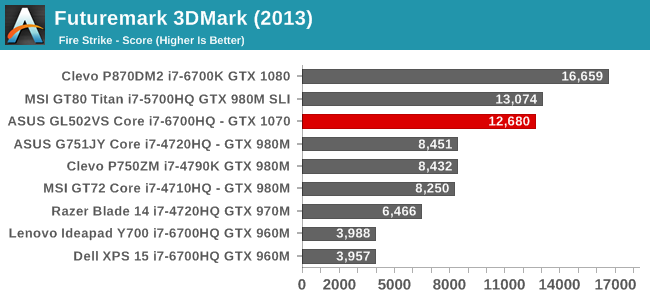
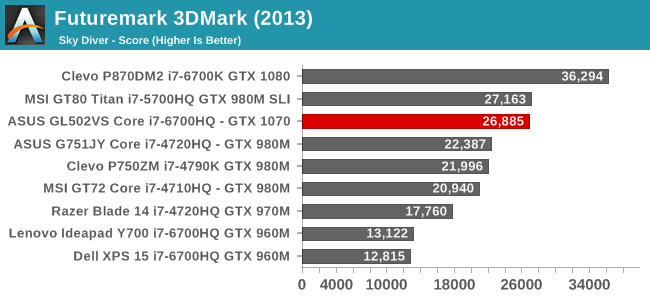
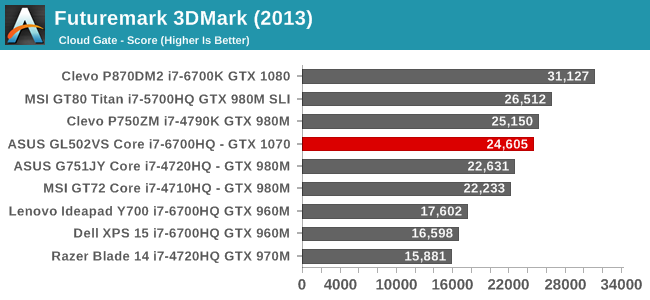
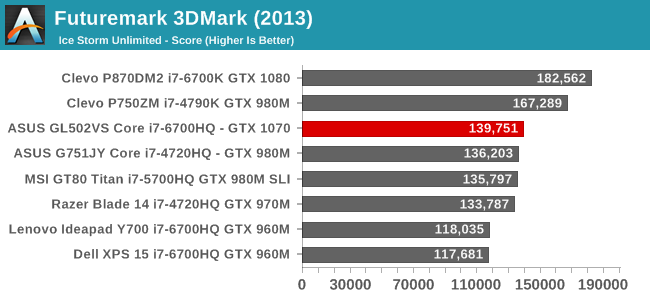
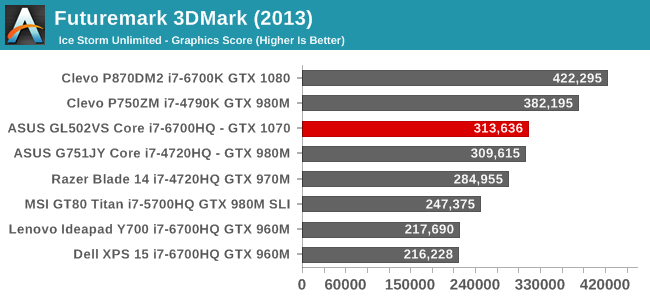
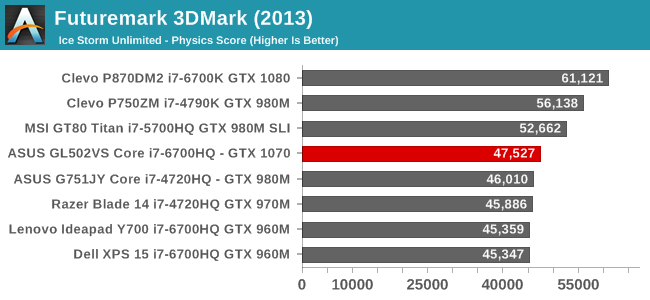
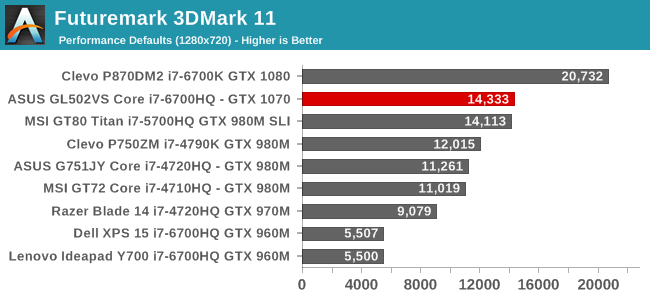
With the more difficult tests of Fire Strike and Sky Diver, the GTX 1070 is within spitting distance of the MSI GT80 Titan with SLI GTX 980M, showing just what a jump in performance the GTX 1070 is. One step under the GTX 1080, and there is still roughly the same performance as the best SLI laptop available with Maxwell. Not a bad start.
GFXBench
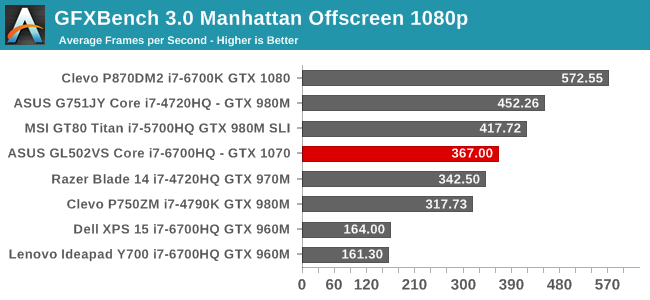
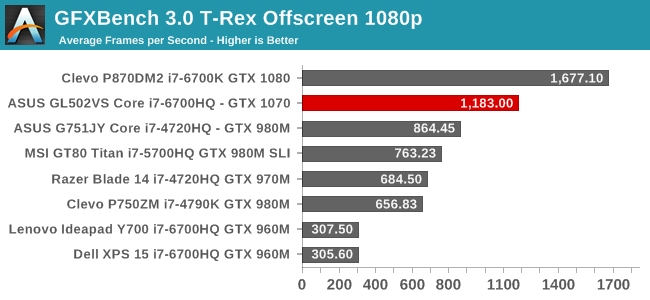
Both of the tests from the older version of GFXBench are really starting to show their age, with scores that are on the far side of ridiculous. The T-Rex scores are kind of insane for both of the Pascal laptops, with results well over 1000 frames per second. The latest version of the test includes some more difficult rendering, and this version will be the new default very soon.
Dota 2 Reborn
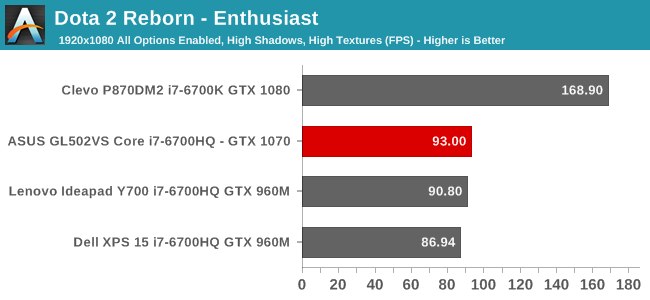
Valve updated the Dota 2 engine quite a while back now, and despite their best efforts, it is still largely a CPU bound test. The GTX 1070 would normally run laps around a GTX 960M, but they are within a couple frames per second of each other with the same CPU available, while the Clevo runs away with this test thanks to the inclusion of a desktop class 95-Watt processor.
Tomb Raider

Although several years old, with everything at maximum Tomb Raider can still be punishing to slower graphics processing units, but with the benefits of Pascal and a much more power efficient architecture, the ASUS GL502VS is once again right on the heels of the SLI GTX 980M found in the GT80 Titan. That seems to be a pretty consistent result, which is very impressive for a mid-range GPU.
Rise of the Tomb Raider

The latest version of Tomb Raider is a beautiful game to look at, especially with everything at maximum. The ASUS compares very well here, still averaging almost 100 frames per second. Be warned though, ASUS does offer a version of this laptop with a 4 GB GPU, and you need more than 4 GB of memory to run this game at its maximum settings, so be sure to future proof yourself with an 8 GB model.
Civilization VI



Although the game is new, the underlying engine is pretty much the same, and Civilization continues to be a mostly CPU bound game. Since the last review of the GTX 1080 Clevo, the benchmark has been updated and the scores from that system are no longer valid, so for the time being there is just a single result here, but as you can see there is very little difference between maximum settings and minimum, as far as frame rate. Interestingly they’ve also added a new test to determine the average amount of time between turns, and that should be useful for future reviews as a CPU test.
Bioshock Infinite
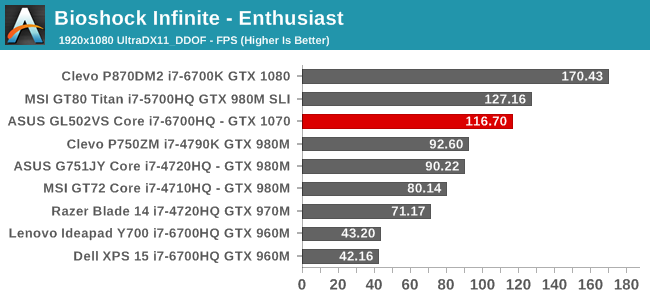
Once again this game is getting a bit old, but it’s still very fun, and can be quite demanding at maximum settings. Pascal is really taking this game for granted though, as even on the maximum settings the frame rate is still very high, and once again it is right behind SLI GTX 980M.
Dragon Age: Inquisition
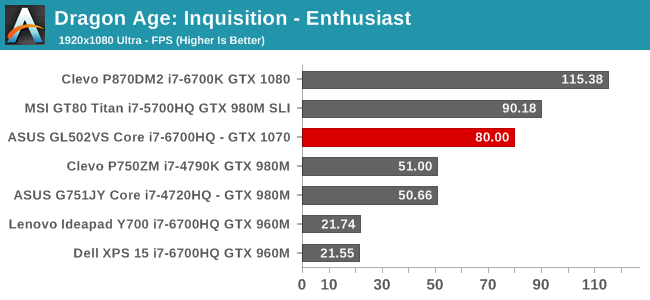
Although behind the GT80 Titan, the ASUS GL502VS is very much right up there when playing this amazing RPG from the end of 2014. There is a healthy step up from the GTX 980M, and the GTX 960M cards aren’t even playable at these settings.
Shadow of Mordor
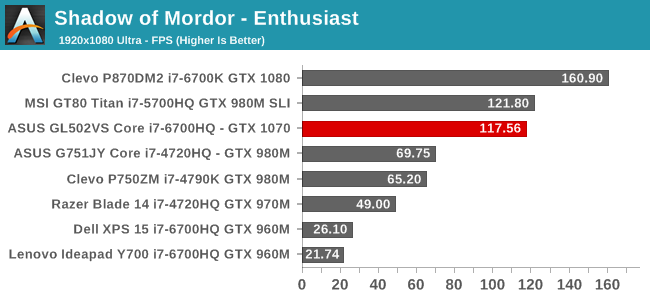
The theme continues, with the GTX 1070 only a hair behind the SLI gaming powerhouse from a year ago.
Grid Autosport
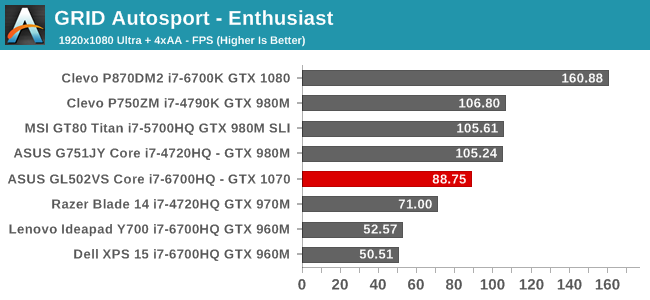
Here we see a bit of a role reversal, with the GTX 1070 falling slightly behind the GTX 980M. This game tends to be CPU bound though, and it’s likely a driver optimization issue here. Regardless, at almost 90 frames per second, it is still not a problem to play.
GPU Conclusion
Maxwell was a big launch for NVIDIA, and the GTX 980M continues to be a pretty powerful GPU, but with FinFET available, Pascal based cards are a huge jump in efficiency. It seems to be pretty consistent in the tests that the GTX 1070 was neck to neck with the SLI GTX 980M, while the GTX 1080 jumps clear of everything by a big margin. The step down to the GTX 1070 from the GTX 1080 is a decent sized step, but regardless the performance of the GTX 1070 is very impressive. Compared to a gaming laptop from a year ago, the ASUS GL502VS is basically on par with the fastest SLI laptops around which is quite an accomplishment.
Most of these games would be playable at UHD resolution (3840x2160) but some of the settings would have to be tweaked for better performance. There isn’t quite enough headroom like on the GTX 1080 to really go for UHD gaming. Just be sure to pick up the 8 GB graphics card to avoid issues in the future, since both a 4 GB and 8 GB model are available.










54 Comments
View All Comments
mobutu - Sunday, December 11, 2016 - link
Look at those big fat ugly bezels ... pathetic @2016Nowadays I'm not even reading a review if bezels arent slim. No way I'm buying that shit.
This is valid for monitors too.
Mikuni - Sunday, December 11, 2016 - link
Fire the guy who keeps butchering the Insert key on their latest laptops; I returned my last Asus for that, won't buy again with this bullshit.sarth1 - Monday, December 12, 2016 - link
How about testing this laptop with recent games. Civ 6 fine, but seriously, Dragon Age 3? Try it with Witcher 3, Dishonored 2...seanh81 - Monday, December 12, 2016 - link
Bought this one and owned it for a month.ASUS ROG GL502VS-DB71 15.6" FullHD Gaming Laptop,Intel Core i76700HQ,NVIDIA GTX 1070,256GB PCIE SSD+1TB HDD,Windows 10,Black
Month into owning it the OS disappeared after plugging the laptop in. Re-loading OS not an option as Samsung SSD would not be read consistently so opened RMA and sent it back. Paid my own shipping to return it. Got it back and they reloaded the OS. OS installed on the IDE drive overwriting my data drive and the SSD is not being read in device manager or disk management. Asus will not refund my shipping. No information provided as to what they performed on the laptop except problem: error message. Asus manager says they perform qc/testing before sending laptops back but states that informational is internal and will not share. They wanted me to return the laptop again.. no confidence in there support. Returning it to retailer
sundragon - Friday, December 23, 2016 - link
This scares me as I've had mine a week and it's been performing well thus far.VirtualRay - Tuesday, December 13, 2016 - link
I bought this laptop a month ago or so, and I've been having a blast with it! It's worked great so far for the HTC Vive and Oculus Rift + Touch. I was actually able to run the Rift + Touch and a Kinect at the same time (using a type C adapter to plug in the Kinect).I've been able to simultaneously play WoW in 4k on my 4k TV while watching streaming video in my web browser, too, which was pretty sweet. This laptop is a real beast!
The only complaint I have about the laptop is that I ran into a lot of weird boot hangs when I had secure boot enabled. I didn't dig into it much though, so I'm not 100% sure whether it was Asus' BIOS' fault or mine.
Oh, and it gets a little wind-noisy when you run perf-heavy software like Gears of War 4 or VR games. It's not a problem for VR at all, obviously, since you're wearing headphones, but it could be a little annoying for flat-screened gaming. Lightweight games like WoW didn't tax the graphics card enough to make it spin up at 1080p, though.
Nephelai - Wednesday, December 21, 2016 - link
Did you test whether this laptop can be woken from USB external devices? I just bought the P35x v6 only to find it doesn't (not supported as per Gigabyte tech). This is disappointing for me as I often use the laptop as a day to day machine plugged into a monitor, KB and mouse and it's a pain to open the lid and press a key to wake up.I'd be interested to know if the Asus does wake up (so I could swap) or if disabling it is a thing with higher end laptops. Maybe to prevent ppl gaming and overheating with the lid closed?
sundragon - Friday, December 23, 2016 - link
So I've owned this laptop for about a week and I've got some observations and reservations so bare with me. I’ve also updated it to the most recent BIOS .300 and that corrected some of the issues with battery drain, keyboard, etc.I bought this along with a 2016 Razer 14 1060 to see which one I'd like better. I got the laptops because those of us who live in small apartments in the city don't have the luxury of building a desktop PC to game and not a console.
Why didn’t the review compare it to a 1060 laptop? That would benefit people trying to decide if they want to purchase a 1060 vs 1070.
1. The build quality is good but the materials are CHEAP and the logos/accents make it look like I'm a 16 year old and I live in my parent's basement because a Ko0l H@cKerb0i ... It's almost stereotypical /sigh... How about basic black or silver? (Yes this is totally a personal preference).
2. The little orange speakers work well compared to the Razer 1060's. They are louder but less clear. Where they fail is in ergonomics, my left wrist almost always covers the speaker and it's got a noticeable effect on sound quality. Mounting them higher on the deck (like the Razer) or on the front edge (like Alienware) would have taken care of this.
3. More ergonomic issues: How about a beveled edge on the deck so it's not digging into your wrists when you try to play? These reviews are great for components but holy crap, please spend a little time playing with the system to test out simple stuff like that. I've got to put it on a laptop desk at an angle to correct. The Razer1060 beats it in ergonomics hands down.
4. Graphics - It's absurdly fast. Like everything you throw at it currently is buttery smooth with everything set to ULTRA. Witcher 3 with all the setting set to ULTRA and hair turned on was pure joy. I will say the Razer160 plays everything as well but the 1070 will be more future proof in a year or two. Plus if you hook this up to a UHD or 4K monitor, you can actually play the same titles, just not on ULTRA
5. BLOATWARE - Really!?!? I love how this article says there wasn't any - I'm not sure if it's because they send it knowing it would be reviewed but I spent an hour uninstalling all sorts of BS from the computer that have NOTHING to do with gaming. I left the basic ROG software - Literally a few GB of data. Why is this an issue today? FWIW, the Razer had none, literally nothing aside from the basic drivers and Windows Defender for Virus protection...
6. Battery life… The screen flickers when I play Witcher 3 on battery, not sure what causes this but plugging it in fixes that issue. This thing is meant to be near power for any use thanks to G-Sync goodness.
7. 4.8 LBS?!? ASUS marketing lies!! LOL. I believe they are weight thinner 502 with the 1060 not the thicker 502 with the 1070. It’s 5.7 LBS – please weigh it before stating that in the review. OH and the power adapter weighs 1.3 lbs, and you won’t be leaving the house without it so the total package weight is important to note (at least with G-Sync laptop battery life). TOTAL package weight for me is 7lbs if I want to move it out of the house (which I probably won’t).
8. Storage and System performance: It’s is buttery smooth (and it should be). It’s got a 256GB SSD plus a 7200 TB HDD, which is a lot better than the measly 256 GB SSD in the Razer. The screen on the Razer is smaller but slightly better quality – really only noticeable when you’re looking at them side to side.
9. Fans are inaudible at idle and audible but don’t overpower the speakers when I’m playing Witcher 3. The Razer Blade 1060’s fans are audible at idle and sound like a small turbine when playing Witcher 3. Thermals – The razer being thinner and aluminum transmits heat to your hands. Temps are well within normal ranges when playing demanding games but the benefit of plastic plays out here where the heat isn’t transmitted to your hands. No throttling for either laptop.
It’s a great value, I bought it for $1399 before tax on sale at Microcenter. The Razer is $1799 with a “weaker” 1060 and only 256GB of SSD. But you get 4.2 lbs weight and the power adapter is tiny and .9lbs for about 5lbs total package weight. An overall 2lbs difference.
If you’re looking for a purely gaming machine, then it’s the one I’d recommend. If you plan on using the laptop outside and care about build quality, and what the aesthetics look like (yes I will be the first that this is subjective) then go with a Razer or a Gigabyte which are understated. You can cover up the Razer fanboy logo with a Dbrand skin to boot.
I'm still on the fence as to which one I'll keep. A lot to like about it but the ergonomics, and build materials apparently matter as much as the cost/build quality/better GPU.
Any questions or hate?
Hal422 - Friday, April 14, 2017 - link
I believe the flicker when unplugged is due to the 180 watt PSU the 1070 needs 200 at full power.inperfectdarkness - Tuesday, January 3, 2017 - link
I was unable to find any of these with 4k screen AND the 1070 GTX card. I ended up getting the Gigabyte P35X v6 instead. P35X is not only thinner, lighter & cheaper...if I'm going to be saddled with only 1 backlighting color on my keyboard...I'd rather have white.